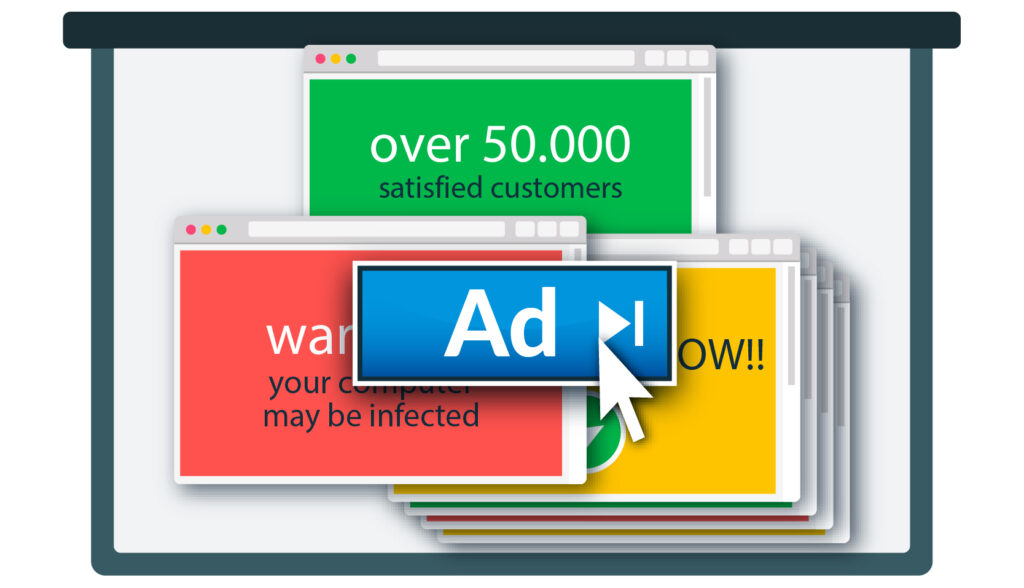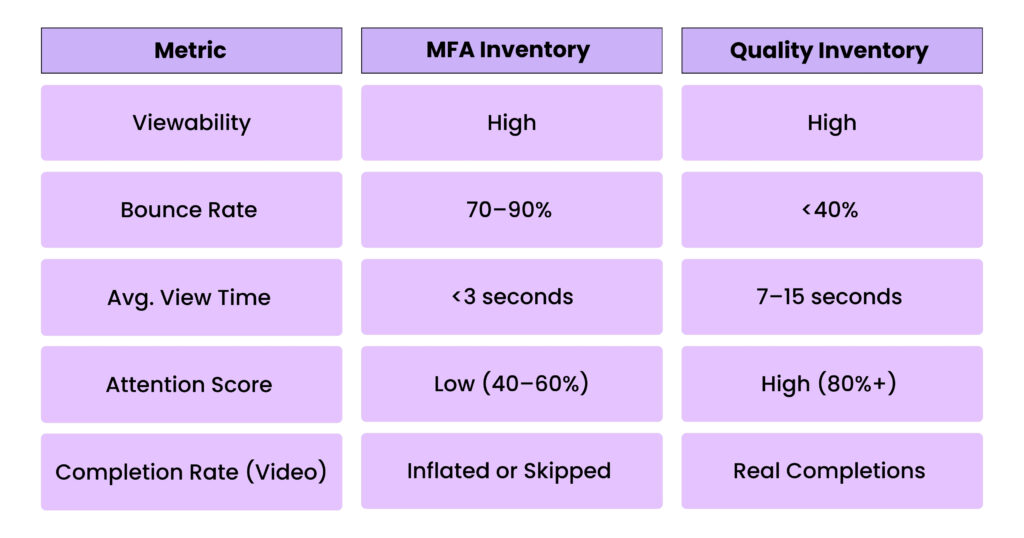Do you usually find yourself wondering what is the real impact of the branding campaigns that I have run? Where did the audience go? Why isn’t the performance on dashboards not translating into outcomes?
Here’s the truth that might hurt a little – An ad ‘seen’ does not mean it is seen by the people who matter.
Your programmatic campaigns, specifically planned to maximize reach, visibility, and engagement, might be only getting seen by bots or irrelevant audiences due to it’s automated nature and vulnerability.
The ads could be running on MFA (Made-for-Ad) sites, pages designed to game the system, packed with cluttered ads and irrelevant content. These environments drain budgets, distort performance metrics, and leave marketers chasing numbers that mean nothing.
According to a report by ANA, brands waste 15% of their ad spend on MFA sites instead of premium inventory, and most marketers don’t even realize it’s happening.
So here’s something you need to focus on if you want to move the needle. Because viewability doesn’t equal visibility, and visibility doesn’t equal attention.
Therefore, marketers still focusing on just the viewability metrics to measure an ad’s performance, need to move beyond vanity metrics and start looking at what really matters – attention measurement or also called attention metrics. For modern marketers measuring attention is a more reliable and smarter way of understanding whether ads are truly working or not.
Let’s understand how it really helps.
In this article, we will unpack:
- What are MFA sites and why marketers need to care?
- Why is viewability no longer a reliable metric to measure ad performance?
- Why is it important to measure attention metrics?
- How to eliminate MFA sites?
- How does an ad fraud solution like Valid8 by mFilterIt help brands to optimize for real impact?
What are MFA (Made-for-Ad) Websites? How These Sites Impact Campaign Performance?
MFA (Made-for-Ad) websites, also called arbitrage sites, are not made for efficiency, visibility, impact, or to reach real audience. They are solely designed to steal the ad revenue being spent by marketers. These sites, on the surface, may look like legitimate publishing platforms with articles, images, or even video content; however, are filled with thin or recycled content, clickbait headlines (often fake news), and layouts overloaded with ads, including tactics that encourage accidental clicks. The working model of MFA sites is to exploit programmatic campaigns by doubling impressions and ad spend, while delivering no real user engagement.
Here’s a quick breakdown of how MFA sites work and manipulate the whole programmatic ad ecosystem:
- Auto-refresh: Ads reload every few seconds, inflating impression counts (CPM metrics) without giving users time to process the message.
- Fake content loops: Articles mimic real stories but lead nowhere, trapping users in an endless cycle of clicks without giving meaningful information.
- Aggressive layouts: Ads are stacked near navigation buttons or scroll traps, tricking users into accidental clicks and artificially boosting CTRs.
- Traffic laundering: The automated nature of programmatic campaigns often bundles MFA domains as safe inventory, making them appear legitimate in DSPs and SSPs.
All this contributes to budget wastage, as most DSPs and SSPs don’t classify MFA traffic as fraud. The impact on campaigns is significant, with high bounce rates, negligible dwell times, and minimal brand recall. For branding managers running branding campaigns, it dilutes your message, associating your brand with poor-quality environments.
Why is viewability no longer a reliable metric to measure ad performance?
Viewability has been the industry standard to measure ad performance for years. According to IAB (Interactive Advertising Bureau) guidelines, a display ad is considered “viewable” if at least 50% of its pixels are visible on the screen for one continuous second, and two seconds in case of a video ad.
A standard that is now too easy for fraudsters to manipulate, and MFA sites do exactly that.
Some common tactics used in MFA sites to inflate CPM campaign models include:
1. Ad stacking

Multiple ads are layered on top of each other in a single placement. Only the top ad is visible to the human eye, but every ad in the stack registers as “viewable.” Advertisers end up paying for impressions that never had a chance of being seen.
2. Pixel stuffing
![]()
Ads are shrunk into tiny 1×1 pixel placements that are invisible to users but still count as “in view.” To reporting systems, the campaign looks like it’s meeting viewability standards, but in reality, no human could ever engage with these ads.
3. Auto-refresh placements

Ads are fixed to corners of the screen or reload every few seconds to inflate impressions. They remain technically viewable but rarely capture user attention.
These tactics make dashboards look green, but in reality, high viewability doesn’t equal high value. Viewability metrics give marketing teams a false impression that their ads are performing, but do not reveal if users genuinely noticed, processed, or engaged with the ad.
This is why relying on viewability alone is no longer enough. It has become a vanity metric, only useful for technical checks, but meaningless when it comes to proving real business outcomes. Today, the focus has shifted to attention metrics, which provide a truer measure of whether an ad actually made an impact or not.
Here’s How Attention Measurement Makes a Difference
Attention metrics are about measuring the reality of how each programmatic or branding campaign performs. These metrics don’t just confirm if an ad appeared on screen; they measure whether it actually captured user interest. This includes tracking metrics such as:
- In-view duration: How long the ad stayed visible.
- Engagement signals: Scroll depth, clicks, dwell time, video played with sound, whether skipped or not, etc.
- Completion with focus: Whether a video was watched without being muted or minimized, and quartile progression.
- Contextual relevancy: Whether the surrounding content was contextually relevant to the ad and encouraged the user to stay.
Here’s what we consistently observe at mFilterIt when auditing campaigns polluted with MFA inventory:

Therefore, unlike viewability, attention metrics reflect real human behavior. It reveals if users scroll past your ad instantly, abandon a page within seconds, or stay to consume the message you want to convey.
Ads that capture attention are far more likely to drive recall, influence perception, and inspire action. Campaigns optimized based on attention metrics are also naturally safeguarded against MFA manipulation, because MFA sites cannot fake genuine engagement.
How Brands Can Protect Their Budget by Eliminating MFA Sites from Programmatic Advertising
The rise of MFA websites has become an industry-wide problem, impacting the effectiveness of programmatic campaigns. These sites thrive on viewability, not value. Therefore, eliminating them requires a conscious shift in how campaigns are planned, measured, and optimized.
1. Move beyond viewability and adopt attention metrics that reveal whether ads are genuinely seen and engaged with.
2. Demand transparency from supply chains. Avoid blind open exchange buys and prioritize vetted private or premium marketplaces.
3. Regularly audit impression logs for domains with high bounce rates or refresh patterns and actively blacklist MFA inventory.
4. Partner with independent ad fraud validation providers like mFilterIt, who can flag MFA-heavy placements and proactively detect sophisticated ad fraud techniques that DSPs and SSPs often overlook.
5. Refuse to spend on low-quality inventory and shift budgets toward attention-rich environments
This way, marketers can protect their budget, brand integrity, and optimize campaigns for real impact rather than just hitting blind spots every time.
How mFilterIt Helps Eliminate MFA Sites and Provides Attention Metrics Intelligence That Matters
At mFilterIt, our ad fraud detection tool – Valid8, provides a comprehensive solution that detects MFA websites, safeguards campaigns, and measures true attention metrics. Here’s how:
1. Proactively Detects MFA and Low-Quality Placements
Sophisticated Algorithms: AI/ML-driven checks extract insights and detect abnormal patterns in traffic and placements.
Deep Content Analytics: Uses NLP (Natural Language Processing) and image/video analysis to flag irrelevant, plagiarized, or unsafe content.
Regional & Contextual Intelligence: Conducts local language and cultural context analysis to assess real brand risk.
MFA Repository: mFilterIt’s ad fraud detection solution continuously updates MFA websites, mapped against campaign metrics to instantly block or blacklist them.
2. Behavioral & Placement-Level Checks
Heuristic and Deterministic Checks: Identifies suspicious domains, inappropriate placements, and frequency capping abuse using various parameters.
Invalid UX Pattern Detection: Identifies sites using ad stacking, refresh spam, or scroll traps to inflate impressions.
3. Attention Metrics Score Algorithm
Attention Score Algorithm: Our ad fraud detection tool uses AI-powered scoring mechanism based on key signals like in-view duration, skip/mute rates, screen orientation, interaction, and completion patterns. It classifies impressions into High, Medium, or Low Intent, helping marketers optimize for quality rather than volume.
Scroll & Dwell Time: Tracks whether content holds user interest beyond impression. It provides custom audience segments based on real attention signals for smarter retargeting.
Creative Stickiness: Measures video and display ads for completions with focus and sound on.
Quartile & Engagement Metrics: It also offers format-specific breakdowns, skippable vs. non-skippable video, device-based patterns, and engagement trends, enabling dashboard-level intelligence with granular insights on what’s working, where attention is being lost, and how to reallocate spend effectively.
The outcome is clear. Instead of optimizing for vanity metrics like viewability, we help marketers gain the ability to refine targeting, adjust creatives, build custom audience segments, and reallocate budgets toward placements that deliver genuine engagement and long-term impact.
Closing Thoughts
The industry has relied on viewability metrics for too long. However, it has now become a blind spot, easily manipulated by MFA websites leading to loss of budgets and much more. Therefore, it’s time for marketers to stop paying for impressions that only look good on paper. Start optimizing for attention, where ads are truly seen, remembered, and acted upon.
Ready to measure the true impact of your programmatic campaigns? Get in touch with our experts today to find out how we can help.




